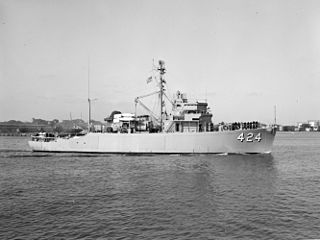
USS Virginia (CGN-38) was a nuclear-powered guided missile cruiser, the lead ship of her class, and the eighth ship of the United States Navy to be named for the Commonwealth of Virginia. She was commissioned in 1976 and decommissioned in 1994.

USS John Marshall (SSBN-611) was an Ethan Allen-class submarine, the only ship of the United States Navy to be named for John Marshall (1755–1835), the fourth Chief Justice of the United States. Originally a fleet ballistic missile submarine designated SSBN-611, she later was reclassified as an attack submarine and re-designated SSN-611.

USS Barney (DD-956/DDG-6) was a Charles F. Adams-class guided missile destroyer in the United States Navy. She was the third Navy ship named for Commodore Joshua Barney USN (1759–1818).

USS Stickell (DD-888) was a Gearing-class destroyer of the United States Navy. She was named for Lieutenant John H. Stickell USNR (1914–1943), who was killed in action at Jaluit Atoll in the Marshall Islands on 13 December 1943 and posthumously awarded the Navy Cross. She was renamed HS Kanaris (D212) on transfer to the Hellenic Navy in 1972.

USS Sampson (DDG-10), named for Admiral William T. Sampson USN (1840–1902), was a Charles F. Adams-class guided missile destroyer in the United States Navy.

USS Tattnall (DDG-19) was a Charles F. Adams-class guided missile-armed destroyer of the United States Navy. She was named for Commodore Josiah Tattnall III USN (1794–1871) — also commandant of the CSS Virginia, and an admiral in the Confederate States Navy – who made the adage "blood is thicker than water" a part of American history.

USS Mitscher (DL-2/DDG-35), named for Admiral Marc "Pete" Mitscher USN (1887–1947), was the lead ship of her class of destroyer of the United States Navy.

USS Manley (DD-940), named for Captain John Manley (c.1733–1793), was a Forrest Sherman-class destroyer built by the Bath Iron Works Corporation at Bath in Maine. The keel was laid down on 10 February 1955. Manley was commissioned on 1 February 1957 and sponsored by Mrs. Arleigh A. Burke, wife of then Chief of Naval Operations, the principal speaker at the commissioning ceremonies, and with Commander William H. Rowen in command.

USS Galveston (CL-93/CLG-3) was a Cleveland-class light cruiser of the United States Navy that was later converted to a Galveston-class guided missile cruiser. She was launched by William Cramp & Sons Shipbuilding Company, Philadelphia 22 April 1945, sponsored by Mrs. Clark Wallace Thompson. The cruiser's construction was suspended when nearly complete on 24 June 1946; and the hull assigned to the Philadelphia Group of the Atlantic Reserve Fleet. She was reclassified CLG-93 on 4 February 1956; then reclassified to CLG-3 on 23 May 1957; and commissioned at Philadelphia 28 May 1958, Captain J. B. Colwell in command.

USS Ray (SSN-653), a Sturgeon-class attack submarine, was the second ship of the United States Navy to be named for the rays.

USS Harry E. Yarnell (DLG/CG-17) was a Leahy-class guided missile cruiser of the United States Navy. Named in honor of Admiral Harry E. Yarnell (1875–1959), she was originally classified as a "destroyer leader" or frigate, in 1975 she was redesignated a cruiser in the Navy's ship reclassification. She was the second of the "double-end" Leahy-class guided missile frigates to join the fleet.

USS Warrington (DD-843) was a Gearing-class destroyer that served the U.S. Navy from the end of World War II to the Vietnam War, when she was damaged by two underwater explosions, causing her to be listed as "beyond repair" and excessed to the Navy of the Republic of China.

USS Coontz (DLG-9/DDG-40) was a Farragut-class destroyer leader/frigate in the United States Navy. She was named after Admiral Robert Coontz, the US Navy's second chief of naval operations.

USS William M. Wood (DD/DDR-715) was a Gearing-class destroyer in the United States Navy during the final year of World War II. She was in commission for 31 years, from 1945 through 1976, serving in both the Pacific and Atlantic Fleets. She was the second Navy ship named for Navy Surgeon-General William M. Wood (1809–1880).

The third USS William C. Lawe (DD-763) was a Gearing-class destroyer of the United States Navy.

USS Basilone (DD/DDE-824) was a Gearing-class destroyer of the United States Navy, named for Gunnery Sergeant John Basilone (1916–1945), who was awarded the Medal of Honor for "extraordinary heroism and conspicuous gallantry in action...." in the defense of Henderson Field during the 1942 Guadalcanal campaign.

USS Aylwin (FF-1081) was a United States Navy Knox-class frigate. She was the fourth vessel named for John Cushing Aylwin. Aylwin was laid down on 13 November 1969 at Westwego, La., by the Avondale Shipyard, Inc.; launched on 29 August 1970; sponsored by Mrs. Charles K. Duncan; and commissioned on 18 September 1971 at the Boston Naval Shipyard, Comdr. Dan E. Fenn in command.

USS Waccamaw (AO-109) was a Cimarron-class replenishment oiler in the United States Navy. She was named after Waccamaw River. The original capacity was 146,000 barrels (23,200 m3).

USS Bold (MSO-424) was an Agile-class minesweeper acquired by the U.S. Navy for the task of clearing mines that had been placed in the water to prevent the safe passage of ships.
USS Terrebonne Parish (LST-1156), originally USS LST-1156, affectionately nicknamed the "T-Bone" by her early crew, was a Terrebonne Parish-class tank landing ship built for the United States Navy in 1952. The lead ship in her class, she was named for Terrebonne Parish, Louisiana, the only U.S. Navy vessel to bear the name. The ship was later transferred to Spain and renamed Velasco (L-11), and was scrapped in 1994.




















